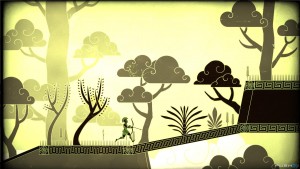Guest post by Core House RA, Brianna Randolph (CAS ’17)
When you take Core, you scrutinize every line in the works of Emily Dickinson, Homer, and Nietzsche, as you analyze and critique their viewpoints on life. After that kind training, it’s only natural that you when leave Core, you notice more. All sorts of details outside the worlds of philosophy and literature catch your eye…. such as video games that seem directly influenced by works we read in Core!
The game is called Apotheon, available on PC and PS4. In style and point-of-view, it resembles standards like Legend of Zelda and Donkey Kong, but in terms of plot it is more like Keats’ “Ode to A Grecian Urn.”
(A quick recap if CC 202 was too long ago for you: In that famous sonnet, Keats ponders the figures on a piece of ancient Greek pottery, expressing wonderment over their immortality as they seem alive but forever frozen in time, mid-action.)
In Apotheon, seemingly painted figures defy Keats’ observations and run, fight, jump, and battle against a clay-like watercolor background, like the art on a Grecian urn come to life. The main protagonist is Nikandreos: a Greek solider drafted to destroy Olympus in a crusade for Hera. In an article describing the game, Somerville writer John Brownlee explains:
The game’s biggest design innovation is its art style, which matches the ruddy silhouetted look of black-figure and red-figure art that took over Greek pottery between the late sixth century and early fourth century BC. In addition to the Elgin marbles and other sculptures, this is the style that we in the 21st century consider synonymous with ancient Greece. Yet when we look at them in museums, what we see, more often than not, are just a bunch of dusty old pots. We forget that to the ancient Greeks, these vases would have been experienced with the same sort of excitement as we experience video games now.
More and more we’re seeing video games based on philosophical or classic texts. Just last week, alum Tom Farndon (Core ’10, CAS ’12) stopped by the Core office to say hello to the staff and give updates on his life four years post-graduation. During our conversation, he made reference to the action-packed, visceral game called Dante’s Inferno, based (very loosely) on the Divine Comedy! And I do mean “very” loosely; the protagonist Dante — who in the books was an average man going through a middle-life crisis in the middle of a forest — is in the game Dante transformed into a beefy young crusader, decked in armor and a bearing a cross that glows with the force of his piety. Despite these departures from the source material, during gameplay the rugged voiceover murmurs quotes directly from the translated Italian (as in this trailer). This pairing of word to action gives the players a sense of “acting out” the feelings and emotions Dante conveyed in his prose.
It’s exciting to see the modern entertainment world, with all its technological complexity, making good use of the eternally relevant (if sometimes dusty!) classics that are the heart of the Core.
Thank you to Prof. Hamill for bringing this game to our attention.


One Comment
Gregory posted on June 25, 2016 at 3:29 pm
Ooh, this is actually one of my favorite videogames in recent memory. It’s absolutely beautiful. In addition to the art design of the world and the characters, the screen itself is textured ruggedly to make it look like the entire game is being played on the side of an amphora.